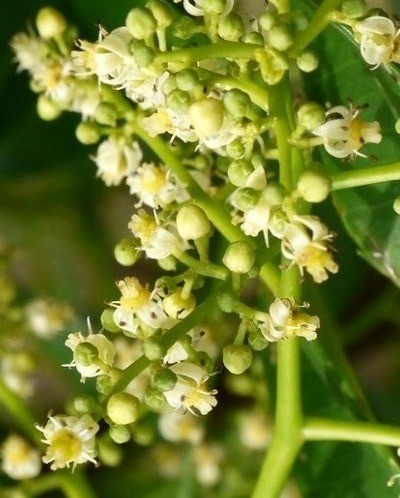Imbu
(Spondias tuberosa)

Description
Spondias tuberosa, commonly known as imbu, Portuguese pronunciation: Brazil plum, or umbu, is a plant native to northeast Brazil, where it grows in the Caatinga, the chaparral scrub that grows wild across dry lands. The round fruit is light yellow to red in colour, around 2–4 cm in size, and has a leathery shell. The flesh is soft and juicy, with a sweet taste and distinct aroma. The fruit comes from a small tree, seldom higher than 6 m, with an expansive crown of up to 393.7008 in diameter. The fruit of the imbu are round and can be of varying size: they can be as small as cherries or as large as lemons. The peel is smooth and green or yellow when the fruit ripen, the small firm fruits are juicy and flavorful and their succulent flesh hides a large dark pit. The name of this tree and fruit comes from the indigenous phrase y-mb-u, which means tree that gives drink. The productive cycle of this wild, spontaneously growing tree begins after ten years of growth. It bears fruit once a year and can produce up to 300 kilos of fruit in a single harvest when it reaches maturity. Due to its robust root system, a great network of tubers that can store liquid throughout the dry summer season, the imbu tree can hold up to 3,000 liters of water during the dry months. This tree is an important resource for one of the poorest and driest regions of Brazil, where local agriculture is based on corn, beans, sheep, and goat (dried and salted goat meat is one of the most important local foods). The fruit of the imbu tree is collected by hand gently, as it is easily damaged and during picking the fruits are set in baskets and bags (in the past these fruits were also collected by beating the branches with long poles, to the detriment of their flavor). The imbu can be eaten fresh or made into jams or other sweetened preserves like fruit cheese. In the Sertão, it is cooked down until the peel and the pulp separate. Then, the liquid is poured off, it is mixed with sugar and cooked for another two hours. After the pulp has been reduced to a glossy gelatin (called geléia), it retains a slightly astringent flavor. In addition to the thick paste made by this long, slow boiling process, the imbu is the base of fruit juice, vinagre (the juice pressed from overripe fruit), and jam (made by pressing together layers of dried imbu paste).
Taxonomic tree:







